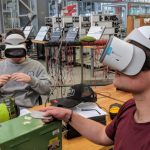Employer training key to competitiveness

In our book Managing for Change, Peter Fritz and I laid out some guidelines for how an individual might set long-term targets in their life and then take steps to work towards them.
One of the ideas we emphasised was the need to be thinking about the skills a person would have to acquire to reach a goal, and the need to create a plan to develop those skills in a timely manner.
Many of those same ideas also hold true in business. Unfortunately, however, it can be a difficult task to find business leaders who have a strong idea of where they want to be in a year’s time, let alone ten.
But failure to think in detail about the future of a business can have some serious consequences.
We know that the pace of change in business accelerating. The internet era has heralded the arrival of a wide range of new competitors onto Australian shores and raised customer expectations for service and product quality.
This trend is not likely to slow down.
The result is that what is expected of a business, and what a business needs to be, could be very different five to ten years from now. And that means the skills it requires to be what it needs to be could be very different also.
Many Australian businesses already report skills shortages, especially for roles which require a high level of specialisation and experience. Being unable to fill these roles means that projects and programs get delayed or are delivered using people who simply may not yet be up to the task, increasing the overall risk within these projects.
Through the course of 2019, TAFE NSW examined the future skills needs of Australian organisations, to understand where the gaps might emerge and how they might be filled. This is being reported back through a series of discussion papers titled The Evolution of Skills. Particular attention was given to four industry sectors: government, transportation, infrastructure and health.
While their specific needs differed, numerous commonalities emerged.
Most startling amongst these was the common requirement for soft skills, such as collaboration skills, problem solving and systems thinking, and human-centred skills relating to communication and customer service.
Much of the emphasis on skills development in Australia has focused on the need for technical skills, and especially STEM skills (science, technology, engineering and mathematics).
The Evolution of Skills found that while the demand for these technical skills will rise, they alone will not be enough to meet the needs of organisations that are having to work in a world that is becoming both increasingly interconnected and more ambiguous, and hence soft skills will become more critical.
Another key outcome from the research was the dawning realisation amongst business leaders that they simply can no longer rely on the market to produce the skilled employees they need.
The growth in requirement for technical skills, and particularly digital skills relating to software development and data analytics, is no longer restricted just to the technology sector alone, meaning the competition for this talent is increasing rapidly.
Similarly, the increasing focus on customer service across almost all industries means there will be greater demand for people with supporting skill sets.
If there is truly a war for talent taking place, we are still only witnessing the opening skirmishes. The lack of available skills is rapidly emerging as a key risk in many sectors and is only likely to get worse.
There is, however, a potential solution to head off these future problems, and for many businesses, it is one that is right under their noses.
Traditional thinking has tended to see organisations overlook existing workers when recruiting for new skillsets.
But if the skills a business needs are proving to be in short supply, then perhaps the answer lies in more closely examining the skills of the existing workforce and identifying those workers who might be suitable for reskilling.
While this has historically been seen as a costly exercise – both in terms of the price of training and the lost productivity inherent in the process – that cost equation can start to look more favourable when compared to the absolute cost of having rolls that are unfulfilled, and hence projects that are not delivered.
The appeal of reskilling is also being heightened by innovative new approaches to training which are less disruptive than traditional methods, such as the use of self-paced eLearning and simulation tools. These have been used to great effect by Transport for NSW to speed up the process of training train drivers and are playing a bigger role in healthcare training.
Short courses and micro-credential programs are also proving more popular, as these break the task of reskilling down into more achievable chunks, while the use of just-in-time learning solutions can also ensure that workers can maximise productivity by only acquiring highly specific or rarely used skills at the time they are needed.
But the key finding is that workforce planners is very clearly back on the radar for many organisations, accompanied by the realisation that creating the skills they need from the people they already have will be much safer option than hoping the market will magically provide them.
Brad Howarth is a researcher, writer, trainer and speaker with more than 25 years’ experience investigating technology-driven change. His latest book, Innovation is for Everyone, written with Peter Fritz, investigates Australia’s patchy innovation track record and future opportunities.








